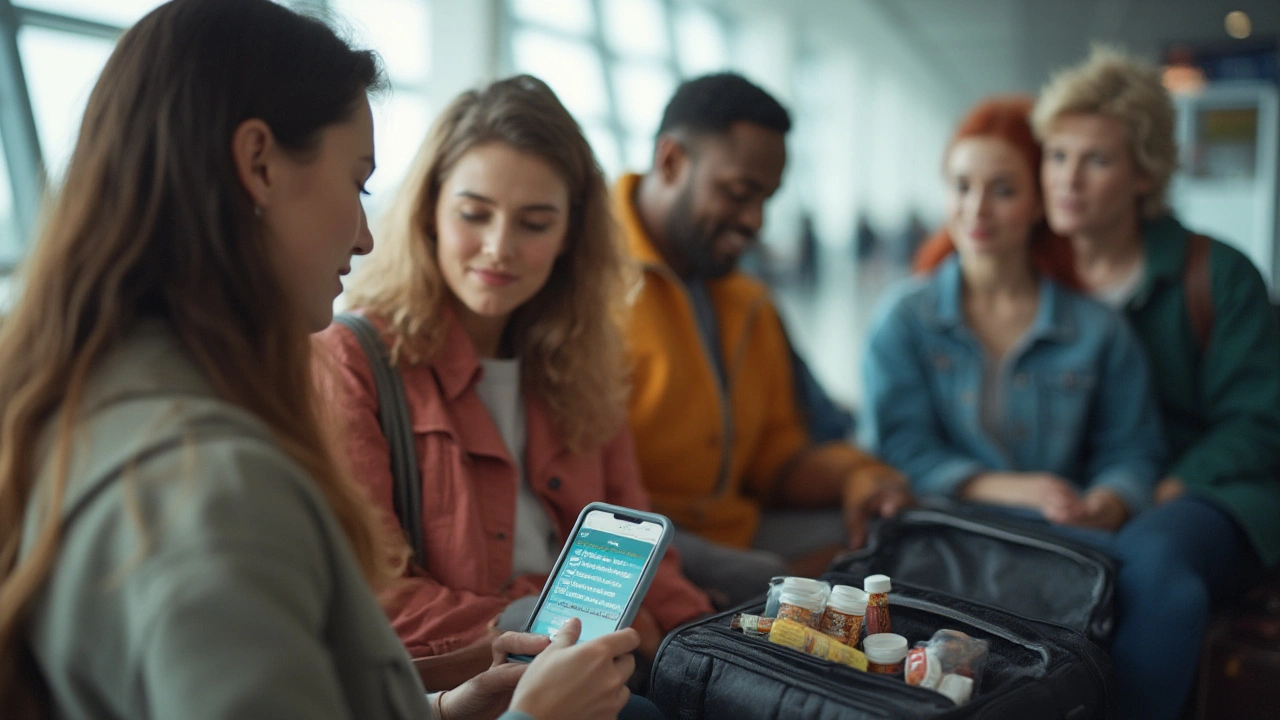There’s nothing like arriving at your dream destination, only to spend your first night in the hotel bathroom wishing you’d remembered to pack that migraine medicine (or at least some decent painkillers). Travel is thrilling, but different environments, foods, and time zones can be tough on your body. Airlines lose bags. Pharmacies close early. Language barriers lead to mix-ups. Packing the right medications is less about paranoia and more about setting yourself up for a holiday that’s smooth, even when hiccups try to join.
Why Packing Medications Properly Matters
Sunscreen and flip-flops usually top packing lists, but medicines often get left until the last minute. It’s easy to assume you’ll pick up everything you need at your destination, but local brands might have totally different packaging or unfamiliar ingredients. For example, common painkillers in the US aren’t always the same as those sold in Europe or Asia. Even paracetamol (acetaminophen) can go by a dozen names worldwide. Imagine standing in a pharmacy in Italy, trying to explain 'heartburn' with elaborate hand gestures, only to walk out with herbal tea instead of antacids.
Then there’s the risk of restricted medications. Certain drugs you grab from your US pharmacy counter—think Adderall, codeine, or pseudoephedrine—are actually illegal or require special permits in some countries. Japan, for instance, has famously strict import rules that have snared travelers carrying cold meds. On top of that, health systems vary. Some countries require a prescription for everything, while others don’t regulate drugs at all, which creates risk for counterfeit or inferior products.
Travel exposes your body to new challenges. Jet lag, different foods, unfamiliar germs, and changes in altitude can all act like speed bumps. Stomach issues, allergies, sunburn, jet lag—these are the annoying realities that can wreck a vacation unless you come prepared. And if you have chronic health issues, running out of necessary meds (because of a delay or lost luggage) is a serious safety concern, not just a nuisance.
Finally, proper packing keeps you compliant with customs. Bringing medicines in original packaging, along with doctor’s notes for anything unusual, can prevent misunderstandings at the border. It’s not unusual for agents to ask questions about pill bottles, especially if you’re traveling with injectables or controlled substances.
The Non-Negotiables: Prescriptions and Vital Medications
If you take daily medicine, this section is your action list. Always pack at least twice the amount you normally need for your trip. Flights get delayed, buses break down, and island ferries love to run on their own mysterious timelines. Don’t keep all your medication in one place; split between your carry-on and checked bag if possible, but prioritize carrying enough in your hand luggage for emergencies.
Prescription medications should always travel in their original containers, clearly labeled with your name, dosage instructions, and doctor’s info. This can make life much easier if you’re questioned by customs officials. Have a printout of your prescription (and ideally, a summary of your condition in English and the local language). For devices like insulin pens, EpiPens, or inhalers, bring more than you expect, plus back-up batteries if applicable.
Traveling with prescription medicine gets especially tricky if you’re headed somewhere with strict drug import laws. The best tip: check your destination’s embassy website for exact requirements. For example, the UAE and Singapore have a zero-tolerance approach for some over-the-counter drugs that are common elsewhere.
If you take medication that needs refrigeration, ask airlines beforehand about ways to keep it cool, and pack a doctor’s letter explaining why you need to carry an ice pack or special storage equipment through security. Airports are getting friendlier about this, but that doctor’s note can be make-or-break if you come across a by-the-book checkpoint officer.
For birth control or hormonal meds, bring enough for your full travel period. Also, consider the impact of crossing time zones. The typical pro tip? Set a phone alarm in your destination’s local time to remind you when to take your doses, rather than trying to remember on your own—it’s ridiculously easy to mess up if jet lag hits hard.
Over-the-Counter Must-Haves: Expect the Unexpected
So you’ve got your usual meds covered. Now comes the fun part—making your emergency travel kit. No two travelers or trips are the same, but some medicines pop up on every must-bring list for good reason.
- Ibuprofen or acetaminophen: These are your go-tos for headaches, minor muscle pain, and those "I wore new shoes all day" feet.
- Anti-diarrheal (like loperamide): New foods and water can surprise your stomach, especially if you stray off the tourist trail.
- Antacid or indigestion tablets: Rich street food in Thailand? Saucy pasta in Italy? Your stomach might stage a protest.
- Antihistamines: Allergy attacks love to strike when you’re not prepared. Fast-acting antihistamines (also useful for insect bites) take up hardly any space.
- Motion sickness tablets: Bumpy bus rides and winding mountain roads are not your friend if you get queasy.
- Topical antibiotic ointment: A small tube of Neosporin can save you a world of hurt from minor scratches or insect bites.
- Hydrocortisone cream: For mystery rashes, itches, or bug bites you can’t resist scratching.
- Melatonin:
- Rehydration salts: These are critical for hot climates or in case of stomach upsets. Electrolyte tablets take up zero space and bring big comfort if you get dehydrated.
- Band-aids and blister plasters: Trust me; nothing ruins a city walking tour like a fresh blister.
Stash these in a clear, resealable pouch that fits in your carry-on, and you’ll be a resourceful hero for your whole group.
Many travelers overlook items like insect repellent or sunscreen as "not medicine," but in reality, these are crucial if you want to avoid bites or burns that can sideline your plans. Modern sprays and lotions are easy to find, but for high-altitude or tropical regions, bring extra-strong formulas—the kind locals recommend, not the travel-sized generic ones at the airport shop.

Special Situations: When Your Destination Calls for Extra Care
Some places need even more careful planning. Visiting countries in Africa, South America, or Southeast Asia may require antimalarial tablets, which must be started before travel and finished after return. Research by the CDC has shown that skipping even a few doses significantly increases your risk. Same goes for yellow fever; some countries won’t even let you in without proof of vaccination, so make digital and paper copies of that yellow card.
If you’re headed somewhere without clean water, consider bringing water purification tablets or drops as part of your kit. In places where medical care isn’t easily accessible, think about bringing a basic course of antibiotics (but always check this with your doctor, as misuse can be risky and may invite big questions at customs). It’s wise to pack a digital thermometer—fever is one of those symptoms where a number beats a guess.
Cruise ships and remote islands change the rules. Seasickness bands, anti-nausea patches, and even prescription anti-motion tablets are gold for rough waters. Plus, the isolated location means you’ll be relying on your kit until you can reach medical help, so don’t skimp on extras.
Altitude meds—like acetazolamide—can be a good idea if you’re heading over 8,000 feet (think Peru or Nepal). The World Health Organization says acclimatization is key, but if you have heart or lung conditions, ask your doctor for personalized advice before setting out. In mosquito-heavy regions, strong DEET sprays and long-sleeved clothing work better than herbal alternatives.
For adventurous eaters, packing digestive enzymes may help with rich or unfamiliar cuisine. Travelers with food allergies should pack several EpiPens or similar auto-injectors, since remote areas may not have them readily available. Always inform travel companions and guides about your allergy and what to do if you react.
Smart Tips for Packing and Staying Organized
Keeping your medication handy and organized matters more than you’d think. Loose pills in plastic bags look suspicious at security. Customs officials want the full, labeled package. Try using a weekly pill organizer for daily doses, but always bring at least one original box or bottle as backup for proof.
Travel-sized zippered pouches, makeup bags, or even clear packing cubes make great mini-pharmacies. Divide items into categories: urgent meds, daily essentials, and "nice-to-haves." This helps you grab what you need without digging through everything each time. Stashing a few items in different bags means you’re not entirely stuck if something gets lost.
Bring a simple medication checklist, and check items off as you pack. Update your travel companions about where that kit is in case you need their help. Many people make the mistake of putting all their eggs in one basket (literally, one pouch)—but if you lose that, you’re left scrambling in foreign pharmacies.
Research local emergency numbers, pharmacy hours, and the location of clinics near your hotel before you travel. Download translation apps or phrasebooks for medical terms—knowing how to say "I need a doctor" or "I’m allergic to penicillin" can save precious time if things go sideways.
Don’t forget to add a waterproof bag or case for beach and pool trips, especially if you’re carrying lifesaving medication. Humidity and sand can quickly ruin pills or creams. If you’re crossing international date lines, set reminders in your phone’s calendar for time-sensitive medications, so you don’t drift off schedule.
Some countries require you to declare all medication at customs. Have that list ready, along with relevant paperwork. If anything’s in doubt, print out travel notices from official embassy or health websites to back up your case.
- Pill organizers are fine for daily use once you arrive, but keep photos of the original packaging on your phone in case officials want to check.
- A small notebook with a running list of medication names, dosages, and uses can save time if you need to visit a foreign doctor.
- Remember: rules about cannabis, CBD, and medical marijuana vary wildly by country and are much stricter than in many US states.
Give someone back home a copy of your medication list and doctor’s contact, just in case you need help from afar while away.
Final Thoughts: Staying Healthy Means Enjoying Every Moment
There’s something empowering about knowing you won’t be sidelined by a random cold, allergic reaction, or migraine while exploring. Bringing the right medications isn’t paranoia—it’s freedom. Fewer worries mean more time to hunt down that hidden tapas bar or watch the sunrise from a mountain top. This is about owning your trip, not letting little things derail your experience.
Focus your packing not just on clothes or tech, but on self-care. Medications may not be glamorous, but they’re often the real MVPs of any successful holiday. Every trip is different—a long weekend in Paris needs something different from a trek in Peru or a beach week in Bali. But one rule works for everyone: being prepared means being able to really enjoy where you are. No panic pharmacy runs. No language-barrier fumbles. Just you, your well-packed bag, and a whole world to explore. Safe travels!







Alan Crierie
July 17, 2025 AT 22:40This is a fantastic guide. It's always a pain trying to remember what to pack for health emergencies while traveling.
I'd add that people should also check the legality of some medications in their destination countries—some things that are common in one place might be controlled or banned in another.
Thanks for raising awareness on this, it'll definitely help folks avoid unnecessary stress and keep their trips enjoyable!
Tiffany Ho
July 20, 2025 AT 10:26I completely agree. Bringing basic meds like painkillers, antihistamines, and your prescription meds is super important.
It’s also wise to have some remedies for stomach troubles since we’re often eating unfamiliar foods while traveling.
Have you guys ever had a situation where you needed something urgent abroad? I think planning ahead makes all the difference.
Nicholas Zeitler
July 22, 2025 AT 18:08Yes!! Never underestimate packing a small first-aid kit—bandages, antiseptic, and a thermometer can save a ton of hassle.
Also, maybe some sunscreen? People forget that a sunburn can ruin your trip more than a cold.
Let’s all carry essentials to make the experience stress-free, right? Traveling should be fun after all!
Zelda Breach
July 26, 2025 AT 05:20Honestly, it’s astonishing how many people think they don’t need any medication on a trip. That’s pure stupidity.
You’re opening yourself up for unnecessary health disasters by not preparing properly.
Pack responsibly. Bring your medications and then some. What’s so hard about that? Safety first.
k arnold
July 28, 2025 AT 12:53Well, I’m guessing this is all common sense, but apparently it’s not to some.
Like, who flies off to another country and forgets their allergy meds? Classic.
Anyway, everyone loves an overprepared traveler, so might as well keep that kit full and you’re golden.
Sam Rittenhouse
August 1, 2025 AT 00:13I think it's crucial to understand the anxiety that comes with being sick in an unfamiliar place.
So having your trusted medications on hand, plus knowing where to get help, can be a huge relief.
It's not just about what you pack physically but about peace of mind emotionally too.
Travel should fill you with excitement, not stress.
Teja kumar Baliga
August 4, 2025 AT 11:33Great points here all. In India, we often emphasize bringing preventive meds too, like antimalarials if going to certain areas.
Also, keeping a digital copy of prescriptions helps when customs or emergencies pop up.
Any suggestions on apps or tools that can help manage medications while traveling?
michael Melanson
August 7, 2025 AT 22:53Apps are a good idea. I’ve used one that reminds me to take meds on schedule and stores info about what I’m carrying.
Made traveling less confusing when dealing with time zones and when doses were needed.
Highly recommend folks look into that kind of tech for their trips.
Denise Young
August 11, 2025 AT 10:13Adding to the medication packing list, I’d say it’s vital to consider your personal medical conditions and carry documents that explain them in detail.
Like allergy info, chronic health issues, and even a letter from your doctor can save a lot of trouble.
Traveling with complex health needs requires such meticulous planning to avoid chaotic situations, trust me.
lucia burton
August 14, 2025 AT 21:33Absolutely agree with everything said so far.
In addition, travelers might want to bring certain supplements or vitamins they regularly use that could be unavailable or differently regulated elsewhere.
That, plus hydration aids and electrolyte replacements, can sometimes be lifesavers when dealing with jetlag or climate shifts.
Preparation is key for optimum physiological resilience on trips.